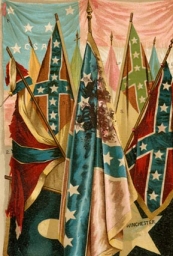© 2006 All Rights Reserved. Do not distribute or repurpose this work without written permission from the copyright holder(s).
Printed from https://danginteresting.com/the-confederados/

Immediately following the American Civil War, some Confederate southerners were unwilling to live under the rule of the triumphant Union. Reconstruction had gone badly for many of these former Confederates as their pre-war lifestyle was gone and replaced with economic impoverishment. Emperor Dom Pedro II of Brazil seized upon this opportunity by offering an alternative. He sent recruiters into Alabama, Louisiana, Georgia, South Carolina and Texas in search of experienced cotton farmers for his country. Many southerners saw this as their only option for happiness; to build a community with southern values in the jungle of Brazil. They would become known as the Confederados.
Dom Pedro offered the disgruntled Southerners a package of tax breaks and grants if they would immigrate to Brazil. General Robert E. Lee asked Southerners not to accept, but about 10,000 Confederates did take the Emperor up on his offer. Eventually about sixty percent of the Confederados trickled back into the United States, but of those who stayed permanently, most became part of a Confederate-values colony northwest of Sao Paulo that was named Americana.
Americana was as much a southern city as one could have in the jungle. Exploratory parties looking for good land to settle were met by cheering crowds and bands playing “Dixie.” Emperor Dom Pedro came to meet the new arrivals. The colonists were ecstatic about what they saw and one wrote back to the Mobile Daily Register:
“I have sugar cane, cotton, pumpkins, squash, five kinds of sweet potatoes, Irish potatoes, cornfield peas, snap beans, butter beans, ochre, tomatoes and fine chance at tobacco. I have a great variety of fruits on my place. I have made enough to live well on and am better pleased than other.”

Slavery was still legal in Brazil— which remained the case until 1888— but it turns out that was not a deciding factor for the Confederados settling there. Primarily they used poorly-paid native workers who were more cost-effective than slaves.
Americana was far enough south that disease-infected mosquitoes were less of a problem than they were in Brazil’s northern regions, but hostile natives were another matter. Settlers occasionally disappeared due to kidnapping natives, especially doctors and dentists. Eugene Harter in “The Lost Colony of the Confederacy” reports on one dentist captured by Indians who was fortunate to have his medical bag with him:
“On demonstrating his curative powers, he soon rose to the position of “medicine god” in the tribe and lived in privileged comfort among them for three years before escaping back to civilization. It cooled his ardor for Brazil. It was believed he soon returned to his native Georgia.”
The Confederados, despite the usual problems of colonization, thrived in an environment that had defeated many settlers before them. Americana became an image of the antebellum period of the American south. Many of the first Baptist churches in Brazil were started there. They built public schools and provided education for their female children, something that was rare in Brazil. They flew the Confederate flag and enjoyed the traditional southern meals of biscuits and gravy, black-eyed peas and, of course, grits.
The settlers had very European names like Stonewall and Butler. They would bake pecan pies, have debutante balls, and sing southern hymns. Only recently was the Confederate flag removed from the city’s crest. In 1906, US Secretary of State Elihu Root made a quick stop in Americana, but had little to say to the expatriates. Root later told his biographer that he left Americana weepy and had told the Confederados they’d never be welcome in the United States again.

For many years Americana remained an insulated island of Confederate values in the Brazilian jungle— a cultural time capsule— but over time the old Southern ways became diluted. Second-generation Confederados began intermarrying and speaking Portuguese, and the land previously used to raise cotton was gradually switched to the native sugar cane. Only a few descendants still live on the land owned by their ancestors, with most scattered throughout Brazil.
Today Americana is a city of 120,000 people with Confederados’ descendants making up only about one tenth of the population. But the ties to the old South live on. Fiesta Confederada is a celebration that takes place every year in Americana. The festival has Confederate flags, Confederate uniforms, food typical of the pre-war South and dances reminiscent of scenes from “Gone With the Wind.”
© 2006 All Rights Reserved. Do not distribute or repurpose this work without written permission from the copyright holder(s).
Printed from https://danginteresting.com/the-confederados/
Since you enjoyed our work enough to print it out, and read it clear to the end, would you consider donating a few dollars at https://danginteresting.com/donate ?